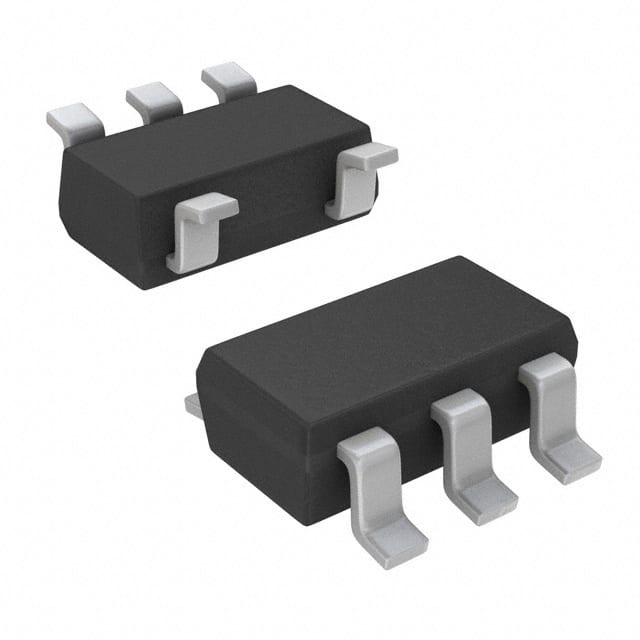Viz Specifikace pro podrobnosti o produktu.

LPV321IDCKR
Product Overview
- Category: Integrated Circuit (IC)
- Use: Operational Amplifier
- Characteristics: Low Power, Single Supply, Rail-to-Rail Output
- Package: DCK (SC-70), 5-Pin
- Essence: LPV321IDCKR is a low-power operational amplifier designed for use in various electronic applications.
- Packaging/Quantity: Available in tape and reel packaging, with 3000 units per reel.
Specifications
- Supply Voltage: 2.7V to 5.5V
- Input Offset Voltage: ±1mV (maximum)
- Input Bias Current: ±1pA (maximum)
- Gain Bandwidth Product: 1MHz (typical)
- Slew Rate: 0.6V/µs (typical)
- Quiescent Current: 50µA (typical)
- Operating Temperature Range: -40°C to +125°C
Detailed Pin Configuration
LPV321IDCKR follows the standard pin configuration for operational amplifiers:
- V+: Positive supply voltage input
- V-: Negative supply voltage input
- IN-: Inverting input
- IN+: Non-inverting input
- OUT: Output
Functional Features
- Low power consumption makes it suitable for battery-powered devices.
- Rail-to-rail output allows for maximum output voltage swing.
- Wide operating temperature range enables usage in various environments.
- High gain bandwidth product ensures accurate signal amplification.
- Low input offset voltage and bias current enhance precision in signal processing.
Advantages and Disadvantages
Advantages: - Low power consumption extends battery life. - Rail-to-rail output provides maximum signal range. - Wide operating temperature range allows for versatile applications. - High gain bandwidth product ensures accurate signal amplification.
Disadvantages: - Limited number of pins restricts the number of input/output connections. - Not suitable for high-frequency applications due to limited bandwidth.
Working Principles
LPV321IDCKR operates as a voltage amplifier, taking an input voltage and amplifying it to a higher level. It utilizes a differential input stage, followed by a gain stage and an output stage. The differential input stage provides high input impedance and amplifies the voltage difference between the inverting and non-inverting inputs. The gain stage amplifies this voltage further, while the output stage drives the amplified signal to the output pin.
Detailed Application Field Plans
LPV321IDCKR finds applications in various fields, including but not limited to:
- Portable Electronics: Battery-powered devices such as smartphones, tablets, and portable audio players benefit from its low power consumption and rail-to-rail output.
- Sensor Interfaces: It can be used in sensor signal conditioning circuits, providing accurate amplification and processing of sensor signals.
- Medical Devices: LPV321IDCKR is suitable for medical devices that require precision amplification, such as ECG monitors and blood glucose meters.
- Industrial Automation: It can be utilized in control systems, data acquisition, and instrumentation applications where low power consumption and accuracy are essential.
Detailed and Complete Alternative Models
- LM358: Dual operational amplifier with similar characteristics and pin configuration.
- MCP6001: Low-power operational amplifier with rail-to-rail output and single supply operation.
- TL072: Dual JFET-input operational amplifier with low noise and wide bandwidth.
(Note: This is not an exhaustive list; there are several alternative models available in the market.)
Word count: 452 words
Seznam 10 běžných otázek a odpovědí souvisejících s aplikací LPV321IDCKR v technických řešeních
Sure! Here are 10 common questions and answers related to the application of LPV321IDCKR in technical solutions:
Question: What is LPV321IDCKR?
- Answer: LPV321IDCKR is a low-power, single-supply operational amplifier (op-amp) designed for use in various technical applications.Question: What is the supply voltage range for LPV321IDCKR?
- Answer: The supply voltage range for LPV321IDCKR is typically between 1.8V and 5.5V.Question: What is the typical input offset voltage of LPV321IDCKR?
- Answer: The typical input offset voltage of LPV321IDCKR is around 1 mV.Question: Can LPV321IDCKR operate in a single-supply configuration?
- Answer: Yes, LPV321IDCKR can be operated in a single-supply configuration, making it suitable for battery-powered applications.Question: What is the maximum output current of LPV321IDCKR?
- Answer: The maximum output current of LPV321IDCKR is typically around 20 mA.Question: Is LPV321IDCKR suitable for precision applications?
- Answer: LPV321IDCKR is not specifically designed for precision applications, but it can still provide good performance in many general-purpose applications.Question: What is the bandwidth of LPV321IDCKR?
- Answer: The bandwidth of LPV321IDCKR is typically around 1 MHz.Question: Can LPV321IDCKR handle rail-to-rail input and output signals?
- Answer: LPV321IDCKR has rail-to-rail input and output capability, allowing it to handle signals that span the entire supply voltage range.Question: Is LPV321IDCKR suitable for low-power applications?
- Answer: Yes, LPV321IDCKR is designed to be a low-power op-amp, making it suitable for battery-powered or energy-efficient applications.Question: What are some typical applications of LPV321IDCKR?
- Answer: LPV321IDCKR can be used in various applications such as sensor interfaces, signal conditioning, portable devices, and low-power audio amplification.
Please note that the answers provided here are general and may vary depending on specific datasheet specifications and application requirements.

